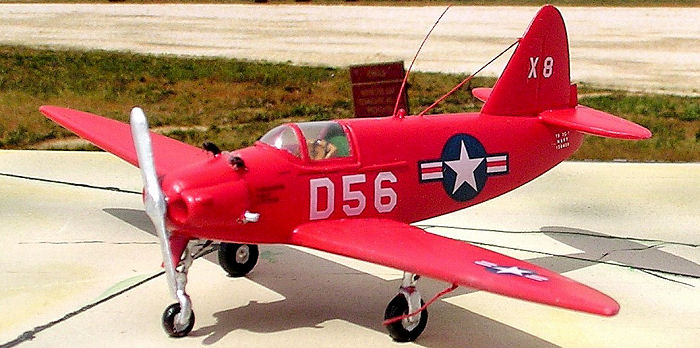
Pavla 1/72 Culver PQ-14
| KIT #: | ? |
| PRICE: | $ |
| DECALS: | See review |
| REVIEWER: | Carmel J. Attard |
| NOTES: | Short run with etched brass and vacuformed parts. |

| HISTORY |
One of the earliest known remotely controlled aircraft operated by the US Navy and Air Force was the Culver PQ-14A. Incidentally Joel Hamm who built two interesting Culver drones and appears under the section ‘P’ of the reviewed kits has already submitted a lot of information about the Culver. The purpose of the Culver drone was to train anti-aircraft gunners and also as a safely training aircraft when pilots go solo. The Culver aircraft was developed by small Culver plant located at Columbus in Ohio. This design was a development of the prewar Cadet sports plane into a full size radio-controlled aircraft for both the US Navy and Army Air Force during the war. The Culver Company eventually moved to Wichita, Kansas to expand to a larger facility for the entire production of the type.
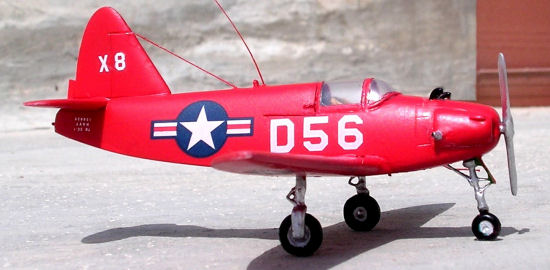 The principal problem with the
early Culver drones was that their maximum speed was 116 mph. This was
unrealistic during the war years when the attacking fighters could be three
times that of the target aircraft type. The Model NRD was developed with changes
that included a higher aspect ratio wing, larger control surfaces to improve
performance and maneuverability and with retractable landing gear. The Culver
NRD always had a single seat cockpit for ferrying and testing duties. 75 PQ-14A
were developed and ordered for full service trials. Finally the USAF acquired
1,433 examples which were later called Q-14A. The last version produced in April
1946 was the Culver TD2C-1 that was contracted for the Navy which received 1,201
examples; a heavier version was later built as YPQ-14B. 1,112 examples of the
PQ-14B were ordered for training duties.
The principal problem with the
early Culver drones was that their maximum speed was 116 mph. This was
unrealistic during the war years when the attacking fighters could be three
times that of the target aircraft type. The Model NRD was developed with changes
that included a higher aspect ratio wing, larger control surfaces to improve
performance and maneuverability and with retractable landing gear. The Culver
NRD always had a single seat cockpit for ferrying and testing duties. 75 PQ-14A
were developed and ordered for full service trials. Finally the USAF acquired
1,433 examples which were later called Q-14A. The last version produced in April
1946 was the Culver TD2C-1 that was contracted for the Navy which received 1,201
examples; a heavier version was later built as YPQ-14B. 1,112 examples of the
PQ-14B were ordered for training duties.
Following that the Culver Company dedicated the entire production to commercial enterprises. After the war a number of Culver drones were converted to civilian sports plane. The type was much admired by those who flew it for its pleasant characteristics during flying as well for its ease of maintenance that it needed. Two aircraft are known to have survived and these are located at the Pima museum in Tucson Arizona and at the USAF Museum in Dayton, Ohio respectively.
| THE KIT |
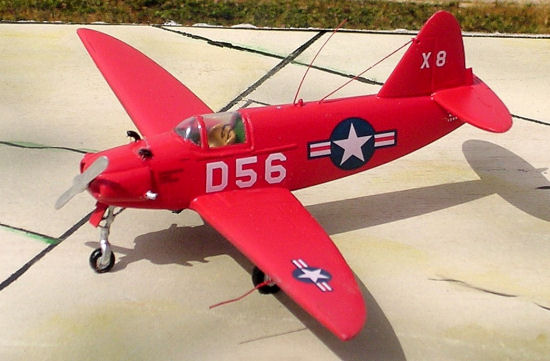 The Culver is an injection
moulded kit released under the brand name Pavla and this ranks among the
smallest that one can find in the 1/72 scale range. The Czech Company produced
the kit as a short run type. All the parts which are moulded in light grey
plastic have a certain amount of flash and sometimes rough edges. Careful
trimming and cleaning however produces the correct shape and is fun building in
spite of its size. I found that the sprue ingates or attachments are rather
large and detaching the components could be a problem and may cause breakage. So
it is recommended to remove parts from sprue using an exacto saw. The few panel
lines that exist on the actual aircraft are also scribed on the fuselage and
wing parts that come in light grey plastic. Along with the kit comes a brass
fret which includes the rudder pedals, landing gear oleo hinges, pitot tube,
seat belts and straps, nose wheel door, tiny aerials besides other small parts.
The cockpit is vacuum moulded and two of them come back to back, one being spare
in case it is needed. The instrument panel is a photo-type printing on clear
plastic sheet. This is glued on a plastic backing also supplied.
The Culver is an injection
moulded kit released under the brand name Pavla and this ranks among the
smallest that one can find in the 1/72 scale range. The Czech Company produced
the kit as a short run type. All the parts which are moulded in light grey
plastic have a certain amount of flash and sometimes rough edges. Careful
trimming and cleaning however produces the correct shape and is fun building in
spite of its size. I found that the sprue ingates or attachments are rather
large and detaching the components could be a problem and may cause breakage. So
it is recommended to remove parts from sprue using an exacto saw. The few panel
lines that exist on the actual aircraft are also scribed on the fuselage and
wing parts that come in light grey plastic. Along with the kit comes a brass
fret which includes the rudder pedals, landing gear oleo hinges, pitot tube,
seat belts and straps, nose wheel door, tiny aerials besides other small parts.
The cockpit is vacuum moulded and two of them come back to back, one being spare
in case it is needed. The instrument panel is a photo-type printing on clear
plastic sheet. This is glued on a plastic backing also supplied.
| CONSTRUCTION |
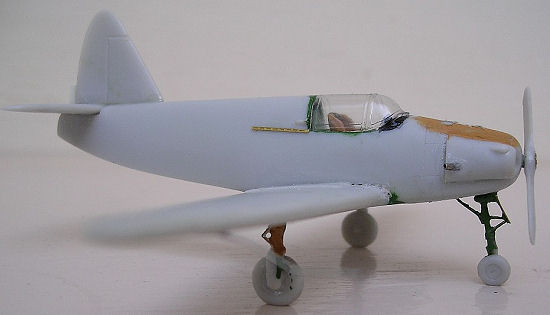 While the instructions are
good, reference to parts location diagram differs from that shown for location
of parts on the sprue. This can delay in locating some parts. There are two
small exhaust parts that are fitted to the lower sides of the cowling that one
has to make his own. This I did using a 3mm long bits of hollow surgical needle.
The aircraft is definitely a tail sitter and it was a real feat to find space to
fill with tiny strips of lead pieces to go inside the limited space of the
cowling. These were held in place with a drop of Kristal kleer. In the end one
can just manage. The decals are of good quality printed by Propagteam and
provide for three aircraft. I opted to do the Navy TE2C-1 that appears on the
box cover. This is an overall bright insignia red with white contrasting
lettering and post war US insignia that was based at Pensacola. Alternatively
one can build the Culver as a 1941 USAAF orange yellow scheme with a respective
insignia or a post war USAF version.
While the instructions are
good, reference to parts location diagram differs from that shown for location
of parts on the sprue. This can delay in locating some parts. There are two
small exhaust parts that are fitted to the lower sides of the cowling that one
has to make his own. This I did using a 3mm long bits of hollow surgical needle.
The aircraft is definitely a tail sitter and it was a real feat to find space to
fill with tiny strips of lead pieces to go inside the limited space of the
cowling. These were held in place with a drop of Kristal kleer. In the end one
can just manage. The decals are of good quality printed by Propagteam and
provide for three aircraft. I opted to do the Navy TE2C-1 that appears on the
box cover. This is an overall bright insignia red with white contrasting
lettering and post war US insignia that was based at Pensacola. Alternatively
one can build the Culver as a 1941 USAAF orange yellow scheme with a respective
insignia or a post war USAF version.
| CONCLUSIONS |
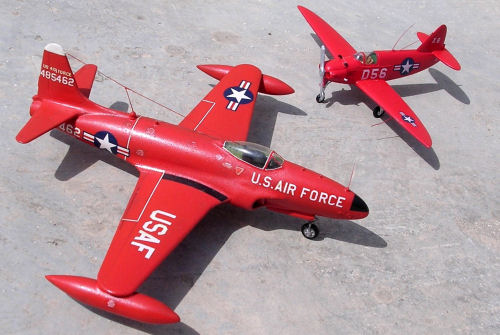 This is a tiny model that
needs careful assembly but in the end it will make a contrast kit and the type I
added to a drone section of my collection In fact it looked quite small when
placed to a drone QF-80C (an Airfix modified kit) in USAF markings, built some
time ago. Pavla Czech Company should be commended for selecting these out of the
ordinary subjects in their list of accurate scale models.
This is a tiny model that
needs careful assembly but in the end it will make a contrast kit and the type I
added to a drone section of my collection In fact it looked quite small when
placed to a drone QF-80C (an Airfix modified kit) in USAF markings, built some
time ago. Pavla Czech Company should be commended for selecting these out of the
ordinary subjects in their list of accurate scale models.
January 2006
Copyright ModelingMadness.com. All rights reserved. No reproduction in part or in whole without express permission from the editor.
If you would like your product reviewed fairly and fairly quickly, please contact the editor or see other details in the Note to Contributors.